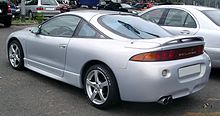Type | |
Stats | 248 20 |
Reviews | (27) |
Uploaded | Apr 13, 2023 |
Base Model | |
Training | Steps: 1,500 Epochs: 1 |
Trigger Words | ECLIPSEGSX |
Hash | AutoV2 2AF1EA6516 |


Pre-facelift Mitsubishi Eclipse coupe

Post-facelift Mitsubishi Eclipse coupe
The Eclipse was redesigned in 1994 (for the 1995 model year) and included standard dual airbags, more rounded styling, a larger interior, and a new engine made by Chrysler for the base model. The second-generation car maintained the market focus of the first-generation car but had numerous changes to appeal to a broader market. A convertible model, named the Eclipse Spyder, was introduced in 1996 offered in two trim levels; the GS and the GS-T. The Spyder GS was powered by a 2.4 L 4-cylinder naturally aspirated 4G64 engine. The Spyder GS-T was fitted with Mitsubishi's 2.0 L turbocharged 4G63 4-cylinder engine. The GSX model was also powered by this engine but with the addition of a high performance all-wheel-drive system. No convertible model was powered by the Chrysler's 420a engine, nor was there a convertible with all-wheel-drive.[11]
The turbocharged engine option was updated for more power as compared to the previous generation (210 hp (157 kW) vs. 195 hp (145 kW)). The naturally aspirated cars had two different 4-cylinder engines depending on the market. The US version engines produced 140 hp, found only in the RS and GS trims, and were a modified version of the Chrysler Neon engine, the 420A, manufactured by Chrysler and delivered to and installed at the Diamond Star Motors facility. The European market engines were a naturally aspirated 4G63 with 141 hp (105 kW; 143 PS). International market Eclipses made less horsepower than their Japanese domestic market relatives when equipped with the 4G63 (210 hp (157 kW), 154 hp (115 kW)), due to emissions regulations.
This model exceeded Japanese government's compact car regulations regarding exterior dimensions (maximum width of 1,700 mm (66.9 in)), therefore incurred a more expensive annual road tax obligation.
A special version of the Eclipse, called the "10th Anniversary OZ Rally", was sold at the end of the 1999 model run with unique 16-inch Enkei wheels with the OZ Racing logo. It also included the leather interior package, accented exhaust exit, “silver” gauges, mud flaps, and higher-profile spoiler that were available as standard equipment on GS-T coupe and GSX models. The special-edition package was only offered with the 420A engine.
A unique version of the 2G Eclipse was sold in some European countries. It used a naturally aspirated Mitsubishi 4G63 motor, similar to what was available in the 1G, unique side-view mirrors, and amber rear turn signals.
A minor style revision was applied for the 1997 model year. The front grille opening was given a more aggressive profile. The headlights were given a sharper slant on the inner edges, and the previous all-chrome fixture interior changed to a black interior with chrome reflector inserts. The driving lights were revised from a reflector type to a smaller projection type. The rear bumper cap was altered and had the reverse lights restyled and moved out into the bumper fascia, away from their original central position by the rear license plate bracket. The GS-T coupe and GSX received a higher-profile rear spoiler. The interior color choices also changed from blue and grey in 1995–1996 model years to black/grey, tan/black, and grey in the 1997–1999 model years.[11] A black leather interior option was only available in 1999; the package included all seats (with the 'Mitsubishi' logo embroidered on both of the fronts), door inserts, and a center console armrest.